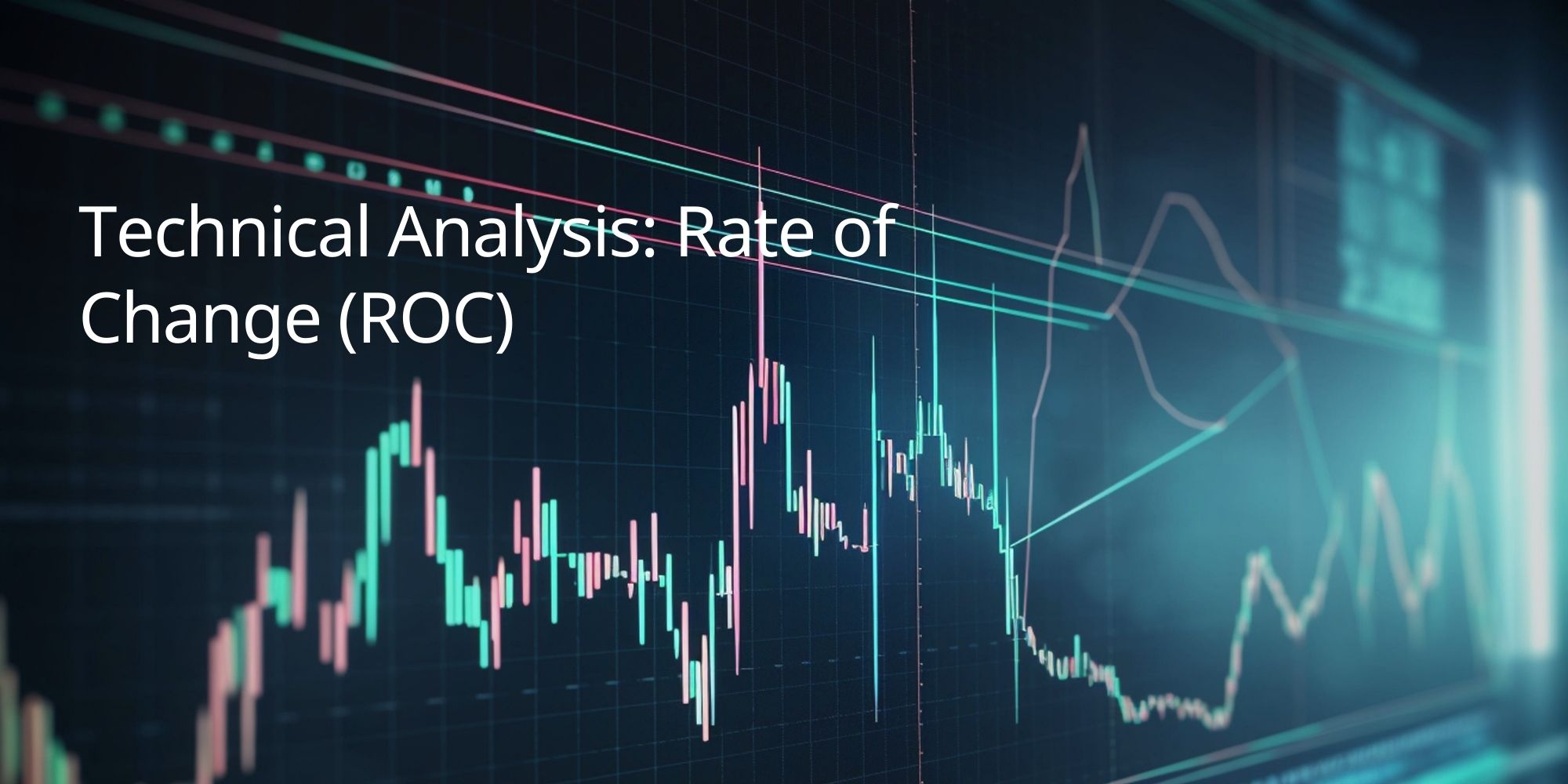Introduction
Momentum plays a crucial role in trading, reflecting the speed and strength of price movements. The Rate of Change (ROC) indicator is an essential tool that helps traders analyze momentum, identify trends, and detect potential turning points in the market.
This comprehensive guide from TradeSmart delves into the ROC indicator in detail. We’ll cover its definition, calculation, interpretation, and practical applications in trading. Discover how to leverage this versatile indicator to refine your strategies and navigate the markets with greater confidence.
Rate Of Change (ROC): What Is It, How It Works, Calculation and Trading
In the fast-paced world of financial markets, understanding price momentum is crucial for making informed trading decisions. The Rate of Change (ROC) indicator is a powerful tool that can help you identify trends, spot potential reversals, and gauge the strength of price movements.
This comprehensive guide from TradeSmart explores the ROC indicator in detail, covering its definition, calculation, interpretation, and practical applications in trading. Learn how to use this versatile indicator to enhance your trading strategies and navigate the markets with confidence.
What Is The Rate Of Change (ROC)?
The Rate of Change (ROC) is a momentum oscillator that measures the percentage change in price between the current price and the price a certain number of periods ago. It helps traders identify the speed and magnitude of price movements.
Who Invented ROC Indicator?
While the exact origin of the Rate of Change (ROC) indicator is uncertain, several individuals played a role in its development and popularization.
- Morton Baratz: An American technical analyst who pioneered the use of momentum oscillators in the 1940s. His work on measuring price changes likely contributed to the foundation of the ROC indicator.
- Tushar Chande: A renowned technical analyst known for his work on momentum oscillators, including the Aroon oscillator and Stochastic RSI. Chande also contributed to the development and application of the ROC indicator.
Despite the lack of a single inventor, the ROC indicator has become a widely used tool in technical analysis, helping traders identify trends and momentum.
How Does The Rate Of Change (ROC) Indicator Work?
The ROC indicator measures the speed and magnitude of price changes over a specific period. It’s displayed as a line that oscillates around a zero line.
- Positive ROC Values: Indicate upward momentum, meaning the current price is higher than the price “n” periods ago.
- Negative ROC Values: Indicate downward momentum, meaning the current price is lower than the price “n” periods ago.
Interpreting the ROC
- Stronger Momentum: Higher ROC values (either positive or negative) indicate stronger momentum.
- Weaker Momentum: ROC values closer to zero indicate weaker momentum.
- Overbought/Oversold: Extremely high ROC values might suggest an overbought market, while extremely low values might suggest an oversold market.
- Trend Reversals: Changes in the direction of the ROC can help confirm trend reversals.
Example:
If the ROC is calculated with a 10-period lookback and the current price is $60, while the price 10 periods ago was $50, the ROC would be:
(($60 – $50) / $50) * 100 = 20%
This positive ROC value suggests that the price has increased by 20% over the past 10 periods, indicating upward momentum.
How Is the Rate Of Change (ROC) Used In Technical Analysis?
The Rate of Change (ROC) indicator is a versatile tool that can be used in various trading strategies. Here are some of its key applications:
1. Identifying Trends and Momentum
The ROC helps traders identify the direction and strength of a trend.
- Uptrend: A consistently positive ROC value suggests an uptrend, with higher values indicating stronger momentum.
- Downtrend: A consistently negative ROC value suggests a downtrend, with lower values indicating stronger momentum.
2. Spotting Overbought/Oversold Conditions
Extreme ROC values can signal overbought or oversold conditions.
- Overbought: Very high ROC values might suggest that the price has risen too far too fast and could be due for a pullback.
- Oversold: Very low ROC values might suggest that the price has fallen too far too fast and could be due for a bounce.
3. Identifying Divergences
Divergences between the ROC and price action can signal potential trend reversals.
- Bullish Divergence: The price is making lower lows, but the ROC is making higher lows.
- Bearish Divergence: The price is making higher highs, but the ROC is making lower highs.
4. Confirming Trend Reversals
Changes in the direction of the ROC can help confirm trend reversals. For example, if the ROC crosses below zero after a period of positive values, it could signal a shift from an uptrend to a downtrend.
5. Assessing Volatility
Sudden and sharp movements in the ROC can indicate increased market volatility. Traders can use this information to adjust their risk management strategies and position sizing.
TradeSmart and the ROC Indicator
TradeSmart provides its clients with access to the ROC indicator and a wide range of other technical analysis tools on its advanced trading platforms. Our educational resources and market insights can help you learn how to use these tools effectively and enhance your trading strategies.
What Is The Formula For The Rate Of Change (ROC)?
The Rate of Change (ROC) is calculated using a simple formula that compares the current price of an asset to its price a certain number of periods ago.
Formula: ROC = [(Current Price – Price “n” Periods Ago) / Price “n” Periods Ago] * 100
Where:
- Current Price: The most recent closing price of the asset.
- Price “n” Periods Ago: The closing price of the asset a certain number of periods ago (e.g., 10 days, 20 days).
Steps to Calculate ROC:
- Choose a Lookback Period: Decide on the number of periods you want to look back (represented as “n” in the formula). This could be days, weeks, or any other timeframe.
- Gather Price Data: Obtain the current closing price and the closing price from “n” periods ago.
- Calculate the Price Difference: Subtract the older price from the current price.
- Divide by the Older Price: Divide the price difference by the older price.
- Multiply by 100: Multiply the result by 100 to express the ROC as a percentage.
Example:
Let’s say you want to calculate the 14-day ROC for a stock. The current price is $50, and the price 14 days ago was $45.
- Lookback period (n): 14 days
- Price difference: $50 – $45 = $5
- Divide by older price: $5 / $45 = 0.1111
- Multiply by 100: 0.1111 * 100 = 11.11%
This means the stock’s price has increased by 11.11% over the past 14 days.
How Does The Rate Of Change Differ From Other Indicators?
While the ROC indicator shares similarities with other momentum oscillators, it has unique characteristics that differentiate it and make it a valuable tool for traders.
ROC vs. Stochastic Oscillator
Both the ROC and the Stochastic Oscillator measure momentum, but they do so in different ways:
- Calculation:
- ROC: Calculates the percentage change in price over a specific period.
- Stochastic Oscillator: Compares a stock’s closing price to its price range over a given period.
- Overbought/Oversold Levels:
- ROC: Doesn’t have fixed overbought or oversold levels. Extreme values, whether positive or negative, suggest potential overbought or oversold conditions.
- Stochastic Oscillator: Typically uses 80 as the overbought level and 20 as the oversold level.
- Interpretation:
- ROC: Focuses on the magnitude and direction of price changes.
- Stochastic Oscillator: Focuses on where the closing price falls within the recent price range.
ROC vs. MACD
The ROC and the Moving Average Convergence Divergence (MACD) are both momentum indicators, but they differ in their construction and interpretation:
- Calculation:
- ROC: Measures the percentage change in price over a single timeframe.
- MACD: Calculates the difference between two moving averages.
- Signals:
- ROC: Generates signals based on crossovers of the zero line and divergences with price action.
- MACD: Generates signals based on crossovers of the MACD line and the signal line, as well as changes in the histogram.
- Timeframes:
- ROC: Can be more effective on shorter timeframes due to its focus on a single timeframe.
- MACD: Often used on longer timeframes to identify broader trend changes.
Key Takeaway
While the ROC shares similarities with other momentum indicators, its unique calculation and interpretation make it a valuable tool for traders. By understanding the differences between the ROC and other indicators, you can choose the right tools for your trading strategy and make more informed decisions.
TradeSmart provides its clients with access to the ROC indicator, the Stochastic Oscillator, the MACD, and a wide range of other technical analysis tools on its advanced trading platforms. Our educational resources and market insights can help you learn how to use these tools effectively and enhance your trading strategies.
What Are The Limitations Of Using The Rate Of Change Indicator?
While the ROC indicator can be a valuable tool for traders, it’s important to be aware of its limitations:
- False Signals: Like any technical indicator, the ROC can generate false signals, especially in volatile or choppy market conditions. This can lead to premature entries or exits if traders rely solely on the ROC.
- Lagging Indicator: The ROC is a lagging indicator, meaning it’s based on past price data. This can sometimes cause the ROC to react slowly to sudden price changes or trend reversals.
- No Fixed Overbought/Oversold Levels: Unlike some other oscillators, the ROC doesn’t have fixed overbought or oversold levels. This can make it more challenging to interpret extreme ROC values, as what constitutes “overbought” or “oversold” can vary depending on the asset and market conditions.
- Requires Optimization: The effectiveness of the ROC can depend on the lookback period (the “n” value in the formula). Traders might need to experiment with different lookback periods to find what works best for the specific asset and their trading style.
Mitigating the Limitations
To overcome these limitations, traders can:
- Combine with Other Indicators: Use the ROC in conjunction with other technical indicators, such as moving averages, trend lines, or momentum oscillators, to confirm signals and filter out false signals.
- Consider Market Context: Always interpret the ROC’s signals in the context of the overall market environment. Consider factors such as news events, economic data releases, and the broader market trend when making trading decisions.
- Practice Risk Management: Use appropriate risk management techniques, such as stop-loss orders and position sizing, to limit potential losses.
TradeSmart encourages its clients to use the ROC as part of a comprehensive trading strategy. By understanding its limitations and combining it with other analytical tools, traders can make more informed decisions and improve their trading outcomes.
Conclusion
The Rate of Change (ROC) indicator is a valuable asset for any trader. By measuring the percentage change in price over time, ROC provides insights into trend strength, overbought/oversold conditions, and potential reversals.
At TradeSmart, we equip traders with the tools and insights needed to effectively incorporate the ROC indicator into their strategies. Our advanced trading platforms, educational resources, and market analysis empower you to:
- Analyze the ROC and interpret its signals.
- Identify trends and assess their strength.
- Spot divergences to anticipate market reversals.
- Combine the ROC with other indicators for a well-rounded analysis.
- Make informed trading decisions based on momentum and price action.
Ready to take your trading to the next level? Sign up with TradeSmart.com today and harness the power of the Rate of Change indicator.
Start Trading




